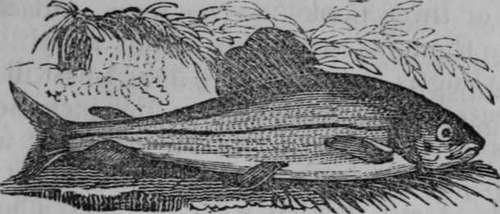A Description Of A Grayling
Description
This section is from the book "The Art Of Angling Greatly Improved", by An Unknown Author. Also available from Amazon: The Art of Angling Greatly Improved.
A Description Of A Grayling
The Grayling is generally found in clear and quick streams with clayey bottoms. It spawns in April, and sometimes as late as the middle of May. The most approved baits for Grayling are lob-worms, gentles, flag-worms, wasp-grubs, cow-dung bobs, cadis-worms, marsh-worms, and brandlings. It may be fished for at all seasons of the year, particularly in cool cloudy weather. There is not any method more killing for large Grayling, than applying the grasshopper to the point of a leaded hook, the lead and shank of which are covered with green and yellow silk, to imitate the body of the insect. In the winter Grayling rise for an hour or two in warm weather, and at this time the smallest imitation of black or pale gnats on the smallest sized hook, succeed best in taking them. In August the red and black ant fly may be considered as a very killing bait.

In cold weather the depth from the ground should be about three inches, in hot weather about mid water. In fishing with gentles two or three hooks may be used, and angle with them as with the artificial fly. The Grayling is a very simple fish, and will rise repeatedly at the bait should he chance to miss it. The tackle should be of the finest description; the bottom to be at least two yards of gut, leaded with two shot about a foot from the hook. It must be observed, that very slender transparent gut, of the colour of the water, is one of the most important causes of success in Grayling fishing. A small goose-quill float must be used; if worms be the bait, the hook should be No. 5 or 6, if maggots, No. 8 or 9. Great caution must be observed in landing the Grayling, as it is very tender-mouthed. Cotton stigmatises the Grayling as one of the deadest-hearted fishes in the world, and the bigger he is the more easily he is taken.
The Grayling may be frequently caught with cabbage-grubs, cod-baits, and grasshoppers, either natural or artificial; the method of angling in this manner is, to allow the bait to sink by degrees to the bottom, and to draw it up again about two feet with rather a sudden motion. When fishing with maggot this plan may also be adopted, but the line requires to be heavier leaded. On these occasions the rod and line must be of equal length, the hook No. 5 or G, and leaded upon the shank.
Continue to:
